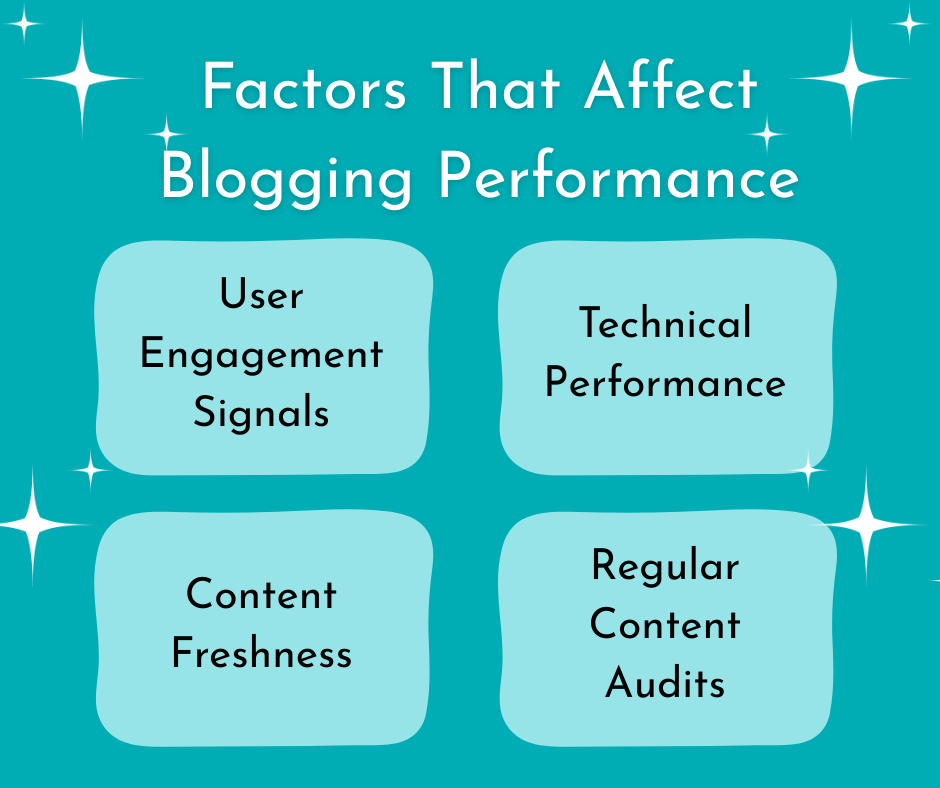Does Blogging Help SEO (And How Often Should You Blog)?
Most small businesses treat blogging like a chore. They write a few posts, share some company updates, and then wonder why their website traffic stays flat.
Blogging falls under search engine optimization (SEO), and it should be done with a strategic approach. When done right, Google and other search engines see your site as active and valuable. With the right SEO strategy, each blog post becomes a new page Google can index and rank.
So, how often should you blog? It depends. While a consistent blogging schedule is important, it's equally crucial to focus on the quality of content. One well-researched, 1,500-word post that answers real customer questions might outperform short multiple blog posts in search engine rankings.
Your blog also feeds your internal linking strategy. Every new post creates opportunities to link to your service pages and other relevant content. It helps build authority and spread it across your entire website.
At Sapphire SEO Solutions, we offer affordable SEO blog writing services to small businesses. Websites with active blogs generate 67% more leads than those without. Our experts have the skills and knowledge to help establish authority and build trust with Google and your target audience.
In this blog, we will go over:
How does blogging help SEO?
How often should you blog?
How should you write blog posts?
Best SEO blog tips to dominate search rankings
Key Takeaways
Blogging efforts can help improve your site's online visibility, start ranking for specific keywords, and drive qualified, targeted traffic. It also builds authority, trust, and credibility.
Several factors, like the industry you operate in, your competition, your website's age, and the resources you have, determine how often you should blog.
Businesses should focus on consistency instead of the frequency of blogs, as that signals to Google that your site is active and up-to-date.
Does Blogging Help SEO?
Blogging is incredibly crucial for your business. Don't just take our word for it. Check out the following statistics that highlight the importance of blogging:
Blogging increases a website's indexed pages by 434%, improving your chances of appearing in search rankings.
Adding a high-quality blog post can drive 55% more traffic to your site.
71% of B2B buyers consume blog content during their buyer journey.
Here are a few ways blogging can improve your site's SEO performance:
Blogging Captures More Search Traffic
Your main service pages target transactional keywords like "technical SEO solutions." But your blog captures the informational searches that happen before people buy. These long-tail keywords bring in qualified traffic.
For example, someone searching "how to choose the best SEO agency for small businesses" might become a client months later. Your blog post answers their questions now and ensures that you're on their mind whenever they decide to convert.
Blog SEO requires a sound SEO strategy. It goes beyond using relevant keywords. We will discuss more about this later on in this blog.
Blogging Builds Topical Authority
Google and other search engines don't just look for keywords anymore. In fact, they encourage businesses to avoid keyword stuffing.
Search engines want to understand if you truly know your subject. Your blog helps you build topical authority by covering a subject comprehensively.
Blogging Spreads Authority Through Internal Linking
Every new blog post creates opportunities to link to your service pages and other relevant content. These internal links help Google crawl your site more effectively and spread authority throughout your website.
Blogging Demonstrates Expertise and Trust
Google wants to rank content from experts. Your blog is your best tool for showing real experience and knowledge. Case studies, how-to guides based on actual client work, and original research all demonstrate expertise.
Businesses should hire actual experts to write or contribute to blog posts. This authentic experience comes through in the content and helps build trust with both users and search engines.
Blogging Attracts Natural Backlinks
High-quality blog posts attract links from other websites. In fact, websites with active blogs earn 97% more inbound links than those without. When you publish an insightful industry report or comprehensive guide, other sites will link to it as a valuable resource.
Link building doesn't just pass authority to your site. It builds brand awareness and extends your reach beyond search engines. This referral traffic from external links can be highly valuable for your business growth.
3 Factors That Affect Blogging SEO Performance
Publishing blog posts isn't enough to start ranking on search engines. There are hundreds of signals that Google uses to determine if your content is worthy of ranking.
Here are the factors that can impact how your blogs perform:
1. User Engagement Signals
Google watches how people interact with your blog posts. The following behavior signals directly impact your rankings:
Dwell time: This measures how long someone stays on your blog post after clicking from search results. When someone spends 5 to 7 minutes reading your post instead of bouncing back in 30 seconds, Google takes notice. This tells the search engine that your content actually answers their question. To reduce bounce rates, make sure your content is comprehensive, well-structured with clear headings, and valuable.
Click-Through Rate (CTR): This metric shows how many people see your blog post in search results and click on it. To improve CTR, you need to craft an engaging blog title and meta description.
2. Technical Performance
Google crawlers hate poorly optimized sites, which makes technical SEO incredibly crucial for your website. If you publish one of the best blog posts you've written in your life and Google can't access it, it won't rank.
Here are a few technical SEO issues that you should focus on:
Site speed: Slow-loading blog posts can be frustrating for users. There are many tools that you can use to fix speed issues, including Google PageSpeed Insights.
Mobile responsiveness: Since Google uses mobile-first indexing, you must make sure your site is mobile responsive. Your blog must work perfectly on mobile devices, as content that's hard to navigate on mobile will affect your rankings.
Crawlability and indexing: If search engines can't crawl your site, you're out of luck. Use Google Search Console to see whether Google has properly indexed your blog posts. Check for common indexing issues, such as blocked pages in robots.txt or missing XML sitemaps.
3. Content Freshness
Users want up-to-date information, and Google wants to provide that. If your blog posts are providing information that's not relevant anymore, you'll see a drop in search rankings.
How often you need to update your blogs depends on your topic and the industry you're operating in. For example, topics related to "AI marketing trends 2025" need to be constantly updated as fresh content surfaces.
Fortunately, you don't need to worry about content refresh when it comes to evergreen topics. For example, an article on "How to budget in 2025" covering everything you need to know about budgeting matters more than the publication date.
Business owners need to find the right balance between publishing fresh content frequently and updating their best-performing existing content with new information.
4. Regular Content Audits
Once you've published a blog post, your job is not over. Make sure to return to the article every now and then for a performance review. Always identify underperforming blog posts that have potential and update them with the following:
Latest information and examples
Improved optimization
New internal links to relevant content
Executing a content refresh strategy after a comprehensive SEO audit may deliver better results than writing entirely new posts.
What Are the Factors That Affect Blogging Frequency?
There are several factors that can affect the number of times you publish blog posts every month. They include the following:
Industry: Fast-moving industries like technology need more frequent updates to stay relevant. You might need up to five high-quality blog posts per week to capture trending topics and maintain authority.
Competition: Check what top-ranking competitors are doing before jumping on the blogging bandwagon. Are they publishing twice a week or once a month? This gives you an idea of what to expect.
Resources: Be realistic about what you can sustain. It's better to publish two high-quality blog posts per month than to burn out trying to post daily with declining quality.
Website's age: New websites (under one year) benefit from slightly more aggressive publishing schedules. We recommend up to eight posts per month to build momentum and help Google understand your expertise.
How Often Should You Blog?
We're often swarmed with questions like "How many blog posts per week?". While we would love to give you a specific number, it's not that simple. You should always follow a strategic approach.
Always Focus on Quality Over Quantity
One comprehensive, well-researched article will always outperform ten shallow posts. Google's algorithms specifically penalize content created just for search engines rather than real users. This means no keyword stuffing and more focus on providing helpful content.
A single 1,500-word guide that thoroughly answers customer questions can drive traffic and rankings for years.
Need Help with Blogging Schedule? Here's What Our SEO Experts Recommend
Based on our experience with small businesses, our SEO managers recommend blogging at least four to six times a month. For those looking to boost traffic and capture more impressions, they can post eight articles every month.
However, it's fine for established businesses to post twice a month. They already have authority and simply need to stay active online.
The Key is Content Consistency Rather Than Blogging Frequency
Google's crawlers learn your publishing patterns. Sporadic publishing with long gaps can lead to less frequent crawling and lower rankings.
Another thing to keep in mind is that your target audience also expects consistency. Regular publishing builds trust and encourages repeat visits, which improves your user engagement signals.
How to Convert Blog Readers into Lifelong Customers in 3 Simple Steps
Getting blog traffic is just the first step. The real goal is to convert those readers into leads and customers. Here's how to optimize your blog content to drive actual business results:
Step 1: Match Content to Where Customers Are in Their Journey
Not every blog post serves the same purpose. Some are informational, while others aim to convert. Smart businesses create content for different stages of the buying process, which includes the following:
Awareness Stage (Top of Funnel)
During this stage, your readers are just discovering they have a problem, and they're searching for more information. This means that they're not ready to buy yet.
To pique interest or provide information, always consider writing posts like "What is email marketing?" or "Common small business accounting mistakes." Focus on educating and informing your target audience, which can also help build trust.
Consideration Stage (Middle of Funnel)
In this stage, readers understand their problem and are researching solutions. They're comparing options and looking for best practices.
To help readers decide the best solution, you must focus on creating content like "Top 5 accounting software options for small businesses" or "Email marketing vs. social media marketing." Your blog posts should sway engaged readers towards a particular product or service.
Decision Stage (Bottom of Funnel)
During this stage, readers are ready to make a purchase decision. All you need to do is provide validation, pricing information, and proof that your solution works. Case studies, detailed price breakdowns, and "Why choose us" posts are great ways to encourage informed decision-making.
Step 2: Incorporate Strategic Calls-to-Action
Always customize your call-to-action (CTA) based on the blog post you're writing instead of slapping a generic CTA at the end of each article. Integrate a contextual CTA or provide a complimentary, detailed guide for better conversion rates.
Step 3: Monitor and Track Key Metrics
Don't just measure your site's traffic and rankings. You should also focus on tracking the metrics that impact your business, including the following:
Micro-conversions: See how many people have signed up for newsletters and downloaded the free guides. Also, look at the time users spend on your pages. These indicate that readers are moving through your funnel.
Macro-conversions: You should also track the metrics that indicate people are taking action after reading your blog posts. These include analyzing demo requests, contact form submissions, and sales.
Lead quality: Some leads can be duds, which is why it's important to work with your sales team to assess lead quality. Are blog-generated leads converting into more customers at a good rate? This tells you if you're attracting the right audience.
How Should You Write Blog Posts?
With the rise in AI writing tools, many business owners are contemplating using them to curate content. But does this strategy actually work? How should you write blogs?
Here's what we've learned from the recent AI-related webinars and years of search engine optimization:
You Should Use AI Tools to Make Blogging Easier
Google doesn't penalize AI-generated content. It rates poorly written content that doesn't provide any value pretty low. While AI can help create a blog post, it's important to do the heavy lifting yourself.
AI tools are a great way to work faster. You can use them for topic suggestions and creating an outline. You can even ask the tool to expand on the points it mentions in the outline. However, human review is crucial.
Demonstrating your experience matters more than what any AI tool can write. If you run a plumbing business, your years in the industry give you insights that an AI tool may not have. This makes it crucial to only use AI for organizing your thoughts.
AI content also sounds generic, and it can be a huge turn-off for your readers. If visitors aren't staying on your blog posts longer than they should, Google takes that as a negative sign. This can affect your search rankings.
Focus on "People-First" Content
Google releases major updates several times a year. It impacts businesses and their blog SEO strategy, requiring a new approach to search engine optimization.
When an update hits, don't panic. Analyze your web pages to identify which ones have lost rankings and why. Typically, it's outdated content that takes a hit after an update. You'll need to focus on refreshing other pages with content that people are looking for.
The key is focusing on "people-first" blog posts. Ask yourself: Would this blog post help someone even if search engines didn't exist? If the answer is no, rewrite it.
Create Ever-Green Content
Chasing every SEO trend wastes time and money. Smart businesses focus on building topical authority around their core services.
Instead of writing random blog posts about trending keywords, create articles around what you do best. If you're a local accountant, become the go-to resource for small business tax questions in your area.
Evergreen content pays dividends for years. A well-written guide to quarterly tax planning will attract clients long after you publish it. Just make sure to update it annually to stay relevant.
Making Every Post Count
Every blog post should serve a purpose. Whether it's to inform or sell a service, always include clear CTAs that prompt readers to take action.
Track which posts generate leads and which ones don't. This data helps you focus on topics that actually grow your business, not just your traffic numbers.
6 Top SEO Blog Tips That Can Do Wonders for Your Website!
Most businesses overcomplicate blogging for SEO. They chase trends, stuff keywords, and wonder why they're not ranking. If you're not getting the results you're hoping for, try the following actionable tips:
1. Target Keywords That Actually Convert
Don't waste time on broad keywords that every big company targets. Focus on long-tail keywords that reveal specific buyer intent.
Instead of targeting "accounting software," go after "best accounting software for small restaurants." These longer phrases have less competition and attract people closer to making a purchase decision.
Use Google's "People Also Ask" section to find these valuable keywords. Type in your main service, and Google shows you exactly what questions people are asking. These questions become your blog topics.
When you conduct keyword research, focus on search intent to understand what your target readers are looking for. This is a good starting point that helps you find keywords that match your audience's needs.
Paid tools like Ahrefs and Semrush can help validate ideas, but you can start using free tools like Google Keyword Planner to get started. Plus, it's a great way to get suggestions directly from Google! When you conduct keyword research through these tools, you'll discover the right keywords for your content strategy.
2. Write Headlines That Get Clicks
If your blog post doesn't grab attention from the get-go, you're losing out on potential traffic. Your title tag is your advertisement in organic search results. Make sure to incorporate your important keywords in it naturally, but focus on making people want to click.
Here's an example of what we mean by writing headlines that get clicks:
"How to Choose Project Management Software" works better than "Project Management Software Guide." The first tells people exactly what they'll learn.
It's not meta titles that you need to optimize, but meta descriptions as well. Make sure they act like mini sales pitches. You have 160 characters to convince someone that your content solves their problem.
3. Structure Content for Easy Reading
Most people scan before they read. Your blog posts should be easy to skim through. Here's how you can ensure that:
Use H2 headings for main sections and H3 headings for subsections. This helps both readers and Google understand your content structure.
Keep paragraphs short. Three sentences maximum. Use bullet points and numbered lists when explaining multiple steps or benefits.
Add relevant images, screenshots, or charts. These visual elements break up text and help explain complex concepts.
Name your image files descriptively and add alt text that describes what's in the image. This image optimization tells Google what your images are about, allowing it to rank on image search results as well.
Consider your URL structure as well, ensuring it's clean and includes your focus keywords when appropriate. Also, pay attention to word count - longer posts tend to perform better in search results, with most high-ranking articles containing 1,500+ words.
4. Link to Your Other Content
Internal linking is one of the most underused SEO tactics. When you publish a new blog post, link the article to related existing content on your site. It helps Google understand your expertise and keeps readers on your site longer.
Our SEO specialists recommend using descriptive anchor text. Instead of "click here," use "learn more about our tax preparation services." This approach supports your overall link-building strategy.
When you have one page that performs well, you can leverage it by linking to and from other relevant pages on your site. This creates a network of connected content that search engine algorithms can easily crawl and understand.
5. Make Sure Your Site Works on Mobile
Google ranks mobile-friendly sites higher. Period. Your blog must look good and load fast on smartphones.
Test your site on different devices. If text is too small or buttons are hard to tap, you're losing visitors and rankings.
Another thing that we discussed earlier in this blog is that page speed matters, too. Check Google Search Console to identify speed issues and take corrective action.
6. Build Your Expertise
Google rewards high-quality content written by real experts. You can consider including an author bio with your credentials and experience to show search engines that you're the right person to write about the topic.
To build expertise, always cite credible sources and share original insights from your business experience. A plumber writing about "common pipe problems in older homes" has more credibility than generic advice copied from other sites.
Want to Rank Higher with High-Quality Blog Posts? Seek SEO Blog Writing Services Today!
Whether it's a business or a personal blog, blogging works when you do it strategically. Simply publishing AI content or churning out articles every day won't get your site to rank. While you need to be consistent in your blogging schedule, you also need to demonstrate expertise as well as follow the best SEO practices.
All of this can be too much to handle for small business owners. This is why Sapphire SEO Solutions offers affordable blog post writing services to help your site move up in search rankings. Whether you need valuable content from a financial wizard or a creative food blogger, we've got you covered.
Ready to turn your blog into a lead-generation tool? Call us at 216-600-8091 to schedule a free consultation with an SEO specialist. You can also order blog posts online using our smart ordering system!










